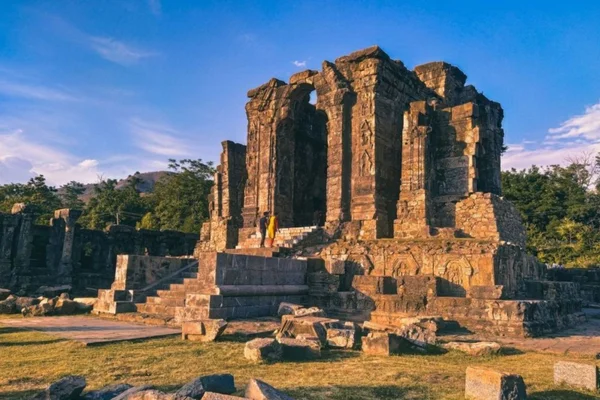Martand Sun Temple, an eighth-century Hindu temple, stands as a testament to the architectural and cultural heritage of Jammu and Kashmir.
About Martand sun temple:
- This is an eighth-century Hindu temple in Mattan, Anantnag in Jammu & Kashmir, dedicated to the Sun-God Surya.
- It was built by Lalitaditya Muktapida of the Karkota dynasty around 1200 years ago.
- Lalitaditya is known to have subjugated the king of Kannauj, which can be one of the reasons for North Indian workers building his temple.
- An architectural blend of Grecian, North Indian, and Buddhist-Gandharan (Kashmiri) styles are reflected in the premises.
- Its temple includes mighty grey stone walls, a three-chambered structure with distinct carvings.
- The temple has a colonnaded courtyard, with its primary shrine in its center and surrounded by 84 smaller shrines, stretching to be 220 feet long and 142 feet broad.
- The primary shrine is located in a centralized structure that is thought to have had a pyramidal top – a common feature of the temples in Kashmir.
- Various wall carvings in the antechamber of the temple proper depict other gods, such as Vishnu, and river goddesses (Ganga and Yamuna), in addition to the sun-god Surya.
- The temple fosterers cultural and architectural richness and now it stands as an Archaeological Survey of India (ASI)-protected monument.
- An ancient monument which is declared to be of national importance by or under the Ancient and Historical Monuments and Archaeological Sites and Remains Act, 1951.
Ref: Source
| UPSC IAS Preparation Resources | |
| Current Affairs Analysis | Topperspedia |
| GS Shots | Simply Explained |
| Daily Flash Cards | Daily Quiz |
Frequently Asked Questions (FAQs):
Who built the Martand Sun Temple and when?
The Martand Sun Temple was built by Lalitaditya Muktapida of the Karkota dynasty around 1200 years ago.
What are the architectural styles reflected in the Martand Sun Temple?
The Martand Sun Temple reflects an architectural blend of Grecian, North Indian, and Buddhist-Gandharan (Kashmiri) styles.
What are some of the distinctive features of the Martand Sun Temple?
The temple includes mighty grey stone walls, a three-chambered structure with distinct carvings, a colonnaded courtyard with the primary shrine in the center, and is surrounded by 84 smaller shrines.
What is the status of the Martand Sun Temple today?
The Martand Sun Temple is an Archaeological Survey of India (ASI)-protected monument and is declared to be of national importance under the Ancient and Historical Monuments and Archaeological Sites and Remains Act, 1951.



